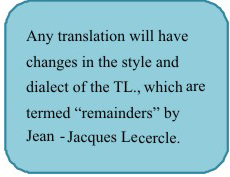The Invariant Core
No transla tion can be undertaken unless the translator is confident of being able to convey some part of the SL text. This salvageable part of the text is termed the ‘invariant' part of the translation process. Gideon Toury considers the most important part of translation to be “the esta blishment of the invariant, its transfer across the cultural-linguistic border and the re-composition of the target message” ( Venuti 470). Venuti points out that the concept of the invariant core will vary depending upon the TL culture and literature. He points out how translators of novels in the present day generally stick to the basic narrative form of the original and do not tamper with the plot. This was not always the case. Abbé Prévost (1697-1763) who translated Samuel Richardson's Clarissa into French, reduced the original seven volumes to four in French. He claimed that he had not in any way changed the author's intention or style, but today we would be inclined to see his work more as adaptation than translation. blishment of the invariant, its transfer across the cultural-linguistic border and the re-composition of the target message” ( Venuti 470). Venuti points out that the concept of the invariant core will vary depending upon the TL culture and literature. He points out how translators of novels in the present day generally stick to the basic narrative form of the original and do not tamper with the plot. This was not always the case. Abbé Prévost (1697-1763) who translated Samuel Richardson's Clarissa into French, reduced the original seven volumes to four in French. He claimed that he had not in any way changed the author's intention or style, but today we would be inclined to see his work more as adaptation than translation.
Although translations today are reluctant to follow Prevost's path, there will invariably be changes in the language like regional and dialectical variations. Jean-Jacques Lecercle calls these changes the “remainder” because they go beyond the basic univocal meaning and focuses our attention on the contexts of the translation. These contexts could be cultural or socio-political. Venuti explains: “The remainder in literary texts is much more complicated, of course, usually a sedimentation of formal elements and generic discourses, past as well as present” (471). The translator in his/her attempt to communicate the text tends to domesticate the foreign text for the consumption of the TL reader. In the process he might go beyond the primary purpose of communication of a message and incorporate effects of language or style that will be significant only in the TL.
|